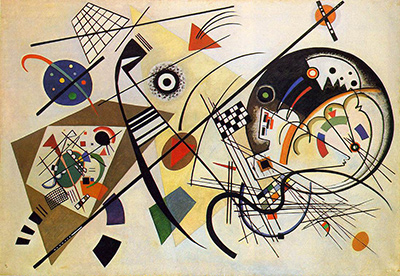A fine example of geometric abstraction, ‘Transverse Line’ was crated by Wassily Kandinsky in 1923.
The original oil on canvas measures 141 centimetres by 202 centimetres, or about 55 inches by 79 inches. One of the most dominate shapes in ‘Transverse Line’ is a circle, a shape that Kandinsky felt represented peace and the human soul. He went so far as describing a circle as romantic.
The circle in this piece is also the most complex element of the painting with various shapes, lines and colours within its border. Although chaotic at a first glance, the painting evokes feelings of optimism and happiness. The painting has similar imagery as Kandinsky’s ‘On White II’, one of the artist’s most famous works that was also completed in the same year.
Transverse Line differs significantly from his early works, which focused on religious and impressionist themes. Earlier paintings often featured abstract representations of actual images and figures, including animals and angels. Later works like ‘Transverse Line’ were much more abstract with a greater emphasis on lines, shapes and colour.
Transverse Lines was created during Kandinsky’s time at the Bauhaus, an art school founded in 1919. He taught classes for beginners as well as a course on advanced art theory until the school was closed in 1933 under pressure by the Nazis. The period was productive for Kandinsky as he developed works focused on points and lines in addition to publishing the theoretical book ‘Point and Line to Plane’ in 1926. Kandinsky examined the effects of forces on straight lines.
He also contrasted tones of curved and angled lines to create stunning abstract works. The painter also attempted to align his art with psychology, especially with respect to colour theory and geometrical elements. During this period, Kandinsky also created ‘Yellow – Red – Blue’ in 1925, which features vibrant colours and shades. He was also one of the Die Blaue Vier, or Blue Four. Former in 1923, the group included artists Paul Klee, Lyonel Feininger and Alexej von Jawlensky.
Wassily Kandinsky was born in Moscow on 4 December 1866, although he spent his childhood in Odessa. The Russian painter and art theorist is known as an early innovator in abstract works as well as expressionism. His treatise ‘Concerning the Spiritual in Art’ (1910) outlines Kandinsky’s championing of abstract colour and form as means to illustrate an artist’s “inner life”.
At the same time, the painter believed in a strong relationship art has with classical music. He attempted to match colours with musical notes in many works. The relationship between music and art was beautifully showcased in his ‘Composition VI’ from 1913, where forms and colours crashed into each other on the canvas.
A student of law and economics, he began studying art when he was 30. By 1896, Kandinsky was studying in Munich including at the Academy of Fine Arts. One of Kandinsky’s most famous works is ‘Der Blaue Reiter’ (The Blue Rider) in 1903. The painting shares its name with a group of Russian artists in Germany against the traditional and strict principles of the Neue Künstlervereinigung in Munich, including Alexej von Jawlensky and Marianne von Werefkin. The group, which played an important role in promoting the Impressionism art movement, also consisted of German artists such as Franz Marc, August Macke and Gabriele Münter. With the start of the First World War, Kandinsky returned to Russia in 1914 before resettling in Germany during 1921. He left his native country disillusioned after the Russian Revolution and new Communist views on art. His later life was spent in France, where he died in 1944.




